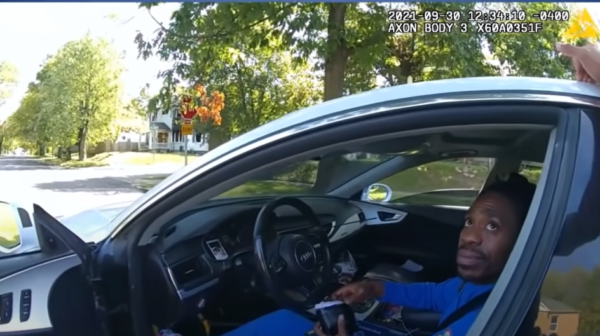An investigation has been launched into the arrest of a Black Ohio man after police bodycam footage showed officers dragging the parapelgic individual out of his car during a traffic stop last month.
The man has since filed a complaint with the Dayton Unit NAACP. “They dragged me to their vehicle like a dog, like trash,” Clifford Owensby said during a news conference on Sunday, October 10.

The Dayton branch president Derrick Foward told the Washington Post that they are in collaboration with Owensby’s attorneys.
“To pull this man out of the car, by his hair — a paraplegic — is totally unacceptable, inhumane and sets a bad light on our great city of Dayton, Ohio,” Foward said in a statement to the outlet. Meanwhile, Dayton’s Mayor Nan Whaley described the footage as “very concerning.”
The incident took place on Sept. 30, when Police Major Brian Johns with the Dayton Police Department said in a statement that officers pulled Owensby over after seeing him leave a suspected drug house they were monitoring.
In the nearly 12-minute video released by DPD, you can hear the officer asking Owensby to step out of the car. The man informs the officer that he is unable to, “I’m a parapelgic. I got help getting in.”
A child was reportedly also in the car at the time of the incident but it’s unclear if they are related to Owensby.
The officer, whose identity has not yet been made public, says he will help Owensby out the car, but the 39-year-old refuses and requests a superior be called. The officer says he will make the call but tells the man he must get out of his car first.
Owensby warns the officer not to touch him stating, “there will be a lawsuit if you put your hands on me for no reason.”
He eventually phones another individual and tells them “come down the street to Ferguson and Grand” and about the ongoing situation. He then instructs them to bring other witnesses and cameras.
“So you can cooperate and get out of the car, or I will drag you out of the car. You see your two options here?” the officer, growing more frustrated, says to Owensby. Soon after, two officers grab the man out of the vehicle with one cop grabbing him by the arm and collar.
Owensby repeatedly yells out during the struggle that he’s a paraplegic and they could potentially hurt him. He is ultimately dragged fully out of the vehicle entirely and onto the ground.
Owensby continues to scream for help before officers handcuff him and take him to their car. Near the end of the clip a cop is seen taking one of Owensby’s shoes that came off during the tussle and tossing it back into the man’s car.
The man was given a citation for failure to restrain a child and for having tinted glass as a result of the incident, according to court records. His lawyer. James Willis, said his client pleaded guilty.
By the morning of Wednesday, Oct. 13, Owensby’s case was on center stage at the seat of city government as he and supporters attended a Dayton City Commission meeting to demand that the officers involved in the incident be suspended and fired. Mayor Whaley attended the meeting and again expressed how she is disturbed by the Owensby’s treatment.
The Dayton Daily News reports that the wheelchair-bound man was sitting in the front row at the meeting, and after Whaley spoke he angrily denounced the city’s show of concern as a farce, shouting: “You should have put out the truth then! Everybody deserves to see the rest of that video and everything that happened in the back of that cruiser.”
Owensby left the meeting after that retort.
President of Dayton Fraternal Order of Police Lodge, Jerome Dix said the officers involved were following protocol, “Sometimes the arrest of noncompliant individuals is not pretty, but is a necessary part of law enforcement to maintain public safety.”


